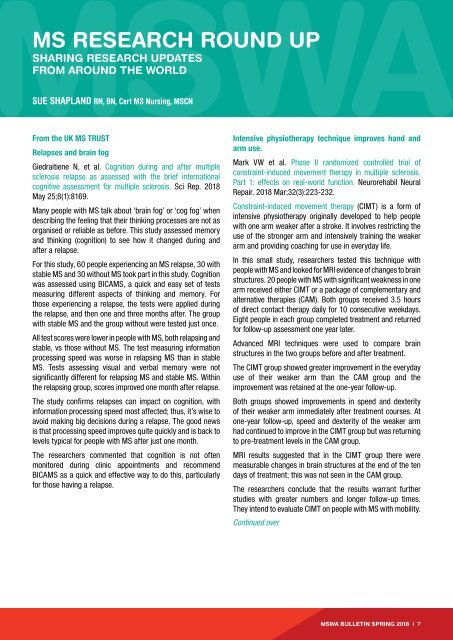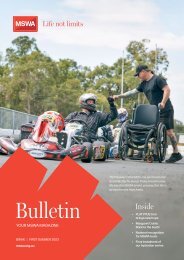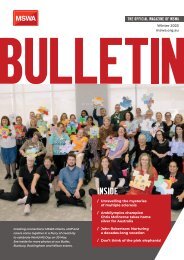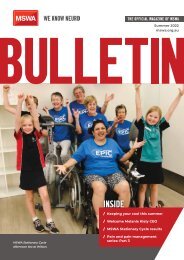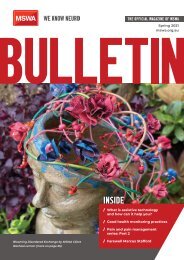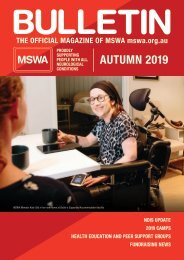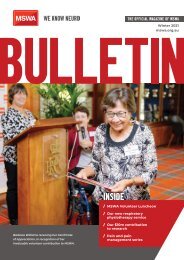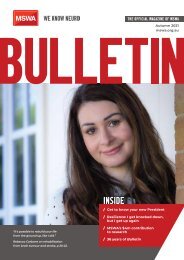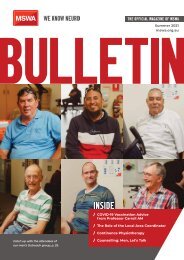You also want an ePaper? Increase the reach of your titles
YUMPU automatically turns print PDFs into web optimized ePapers that Google loves.
MS RESEARCH ROUND UP<br />
SHARING RESEARCH UPDATES<br />
FROM AROUND THE WORLD<br />
SUE SHAPLAND RN, BN, Cert MS Nursing, MSCN<br />
From the UK MS TRUST<br />
Relapses and brain fog<br />
Giedraitiene N, et al. Cognition during and after multiple<br />
sclerosis relapse as assessed with the brief international<br />
cognitive assessment for multiple sclerosis. Sci Rep. <strong>2018</strong><br />
May 25;8(1):8169.<br />
Many people with MS talk about ‘brain fog’ or ‘cog fog’ when<br />
describing the feeling that their thinking processes are not as<br />
organised or reliable as before. This study assessed memory<br />
and thinking (cognition) to see how it changed during and<br />
after a relapse.<br />
For this study, 60 people experiencing an MS relapse, 30 with<br />
stable MS and 30 without MS took part in this study. Cognition<br />
was assessed using BICAMS, a quick and easy set of tests<br />
measuring different aspects of thinking and memory. For<br />
those experiencing a relapse, the tests were applied during<br />
the relapse, and then one and three months after. The group<br />
with stable MS and the group without were tested just once.<br />
All test scores were lower in people with MS, both relapsing and<br />
stable, vs those without MS. The test measuring information<br />
processing speed was worse in relapsing MS than in stable<br />
MS. Tests assessing visual and verbal memory were not<br />
significantly different for relapsing MS and stable MS. Within<br />
the relapsing group, scores improved one month after relapse.<br />
The study confirms relapses can impact on cognition, with<br />
information processing speed most affected; thus, it’s wise to<br />
avoid making big decisions during a relapse. The good news<br />
is that processing speed improves quite quickly and is back to<br />
levels typical for people with MS after just one month.<br />
The researchers commented that cognition is not often<br />
monitored during clinic appointments and recommend<br />
BICAMS as a quick and effective way to do this, particularly<br />
for those having a relapse.<br />
Intensive physiotherapy technique improves hand and<br />
arm use.<br />
Mark VW et al. Phase II randomized controlled trial of<br />
constraint-induced movement therapy in multiple sclerosis.<br />
Part 1: effects on real-world function. Neurorehabil Neural<br />
Repair. <strong>2018</strong> Mar;32(3):223-232.<br />
Constraint-induced movement therapy (CIMT) is a form of<br />
intensive physiotherapy originally developed to help people<br />
with one arm weaker after a stroke. It involves restricting the<br />
use of the stronger arm and intensively training the weaker<br />
arm and providing coaching for use in everyday life.<br />
In this small study, researchers tested this technique with<br />
people with MS and looked for MRI evidence of changes to brain<br />
structures. 20 people with MS with significant weakness in one<br />
arm received either CIMT or a package of complementary and<br />
alternative therapies (CAM). Both groups received 3.5 hours<br />
of direct contact therapy daily for 10 consecutive weekdays.<br />
Eight people in each group completed treatment and returned<br />
for follow-up assessment one year later.<br />
Advanced MRI techniques were used to compare brain<br />
structures in the two groups before and after treatment.<br />
The CIMT group showed greater improvement in the everyday<br />
use of their weaker arm than the CAM group and the<br />
improvement was retained at the one-year follow-up.<br />
Both groups showed improvements in speed and dexterity<br />
of their weaker arm immediately after treatment courses. At<br />
one-year follow-up, speed and dexterity of the weaker arm<br />
had continued to improve in the CIMT group but was returning<br />
to pre-treatment levels in the CAM group.<br />
MRI results suggested that in the CIMT group there were<br />
measurable changes in brain structures at the end of the ten<br />
days of treatment; this was not seen in the CAM group.<br />
The researchers conclude that the results warrant further<br />
studies with greater numbers and longer follow-up times.<br />
They intend to evaluate CIMT on people with MS with mobility.<br />
Continued over<br />
MSWA BULLETIN SPRING <strong>2018</strong> | 7


